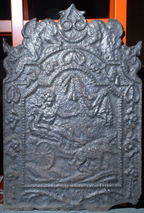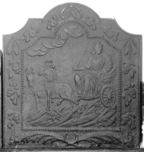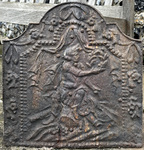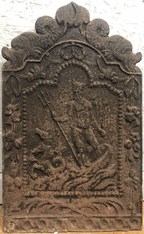-
215
Description: Arched rectangular central panel with canted, cavetto-canted shoulders and bead edging on a broad fillet; seated female figure in a chariot drawn by dogs, symmetrical hanging drapery above right; same-shaped border with fillet edging at top, and suspended ribbons with floral bunches; at base, symmetrical palm leaves tied with ribbon; symmetrical serpents on top their tails intertwined.
Notes: The design is derived from a personification of America, one of a set of playing cards entitled Jeu de la Géographie, designed by Stefano della Bella (1677). The pattern for this fireback, from which the protuberances above the serpents’ heads is missing, is in Rottingdean Grange (no. 930). The pattern, however, has a base panel of a chain-link design, which is missing from this casting.
Copies of this fireback are known.
- Decoration tags:
- 'Dutch' (shape)
- fillet (edging)
- whole carved pattern
- planklines
- pictorial
- allegorical
- animals
- humans
- objects
Manufactured: in the late-17th to early-18th century possibly in the Weald area of England.
Current location: Brighton Museum and Art Gallery, Brighton, East Sussex, England.
Museum number: HATMP002214 (part of the Brighton Museum museum group)
- Attached to series:
- Mayfield 'Dutch' series
- British 'Dutch' style firebacks
-
143
Description: Central panel of arched rectangular shape with cavetto canted corners and bead edging; crowned female figure holding a sceptre in her right hand, seated in a chariot drawn by two caparisoned ponies, a cornucopia at their feet; below, sloping ground with plants, clouds with rain above; identically shaped border with fillet edging and symmetrical swags of flowers and drapery suspended from ribbons; at the base two symmetrical palm fronds tied with a ribbon.
Notes: The figure may represent Ceres, goddess of plenty. The fireback is one of a series designed and made in England, copying the prevailing 'Dutch' style. Its style echoes that of a fireback pattern preserved at Rottingdean Grange, Sussex. Formerly part of the Ade Collection (from Grove Hill, Hellingly, Sussex).
Copies of this fireback are known.
- Decoration tags:
- rectangular with canted top corners and round arch (shape)
- fillet (edging)
- whole carved pattern
- mythological
- animals
- humans
Manufactured: in the early-18th century possibly in the Weald area of England.
Current location: Hastings Museum and Art Gallery, John's Place, Bohemia Road, Hastings, East Sussex, England.
Museum number: HASMG: 1952.51.63 (part of the Hastings Museum museum group)
- Attached to series:
- Mayfield 'Dutch' series
- British 'Dutch' style firebacks
-
1253
Description: Central panel of arched rectangular shape with cavetto canted corners and bead edging; figure seated astride a triumph of weaponry (cannon, spears, drums), holding a laurel wreath in his right hand, surrounded by martial objects (flags, cannon, drums etc.), symmetrical hanging drapery above; same-shaped border with fillet edging and suspended ribbons with floral bunches
Notes: Possibly a depiction of an allegory of Victory. Other firebacks have the same distinctively shaped central panel and border shape, suggesting the same pattern maker. A reduced variant of a more elaborate fireback (no. 456) but missing mirrored serpents on top and probable reed decoration at the base.
- Decoration tags:
- rectangular with canted top corners and round arch (shape)
- fillet (edging)
- whole carved pattern
- pictorial
- humans
- plants
Manufactured: in the late-17th to early-18th century possibly in the Weald area of England.
Current location: in private hands, Kingsdown, Kent, England.
- Attached to series:
- Mayfield 'Dutch' series
- British 'Dutch' style firebacks
-
456
Description: Arched rectangular shaped central panel with canted, concave top corners and bead edging; figure seated astride a triumph of weaponry (cannon, spears, drums), holding a laurel wreath in his right hand, symmetrical hanging drapery above; same-shaped border with fillet edging and suspended ribbons with floral bunches; at base, symmetrical reeds tied with ribbon; base panel with nine linked rings; symmetrical serpents on top.
Notes: Possibly a depiction of an allegory of Victory. Other firebacks have the same distinctive central panel, border shape and decoration at the bottom, suggesting the same pattern maker. A reduced version (no. 1253) lacks the serpents on top and the reeds at the bottom. Formerly part of the J. H. Every collection.
- Decoration tags:
- 'Dutch' (shape)
- fillet (edging)
- whole carved pattern
- pictorial
- mythological
- humans
- objects
Manufactured: in the late-17th to early-18th century possibly in the Weald area of England.
Current location: Anne of Cleves House, Southover High Street, Lewes, East Sussex, England.
Museum number: 1944.24.079 (part of the Sussex Archaeological Society museum group)
- Attached to series:
- Mayfield 'Dutch' series
- British 'Dutch' style firebacks
-
930
Description: Carved wooden fireback pattern. Arched rectangular central panel with cavetto-canted shoulders and bead edging on a broad fillet; seated female figure in a chariot drawn by armadillos, symmetrical hanging drapery above right; same-shaped border with fillet edging at top, and suspended ribbons with floral bunches; at base, symmetrical palm leaves tied with ribbon; symmetrical serpents on top their tails intertwined.
Notes: The design is derived from a personification of America, on one of a set of playing cards entitled Jeu de la Géographie, designed by Stefano della Bella (1677); reputedly from Mayfield; presented to Brighton Museum by Henry Willetts. A casting from this pattern is no. 215.
- Decoration tags:
- 'Dutch' (shape)
- whole carved pattern
- planklines
- pictorial
- allegorical
- animals
- humans
- objects
Manufactured: in the late-17th to early-18th century in England.
Current location: Rottingdean Grange, Rottingdean, East Sussex, England.
Museum number: R3341/7 (part of the Brighton Museum museum group)
Citation: Dawson, C., 1903, 'Sussex Iron Work and Pottery', Sussex Archaeological Collections, 46, pp. 1-54.
Citation: Hughes, G. B., 1960, Collecting Antiques (London, Country Life), pp. 85-93.
Citation: Hughes, G. B., 21 Apr 1955, 'Old English Firebacks', Country Life, 117, pp. 1056-60.
- Attached to series:
- Patterns
- Mayfield 'Dutch' series
-
1224
Description: Arched rectangular shaped central panel with canted, concave top corners and bead edging; naked, crowned figure of Neptune holding a trident in his right hand, standing amid waves and with two hippocampi to his right; same-shaped border with fillet edging and suspended ribbons with floral bunches; at base, symmetrical reeds tied with ribbon; base panel with nine linked rings; symmetrical serpents on top.
Notes: Other firebacks have the same distinctive central panel and border shape, suggesting the same pattern maker.
- Decoration tags:
- 'Dutch' (shape)
- fillet (edging)
- whole carved pattern
- pictorial
- mythological
- animals
- objects
Manufactured: in the early-18th century possibly in the Weald area of England.
Current location: not known.
- Attached to series:
- Mayfield 'Dutch' series
- British 'Dutch' style firebacks




.jpg)
